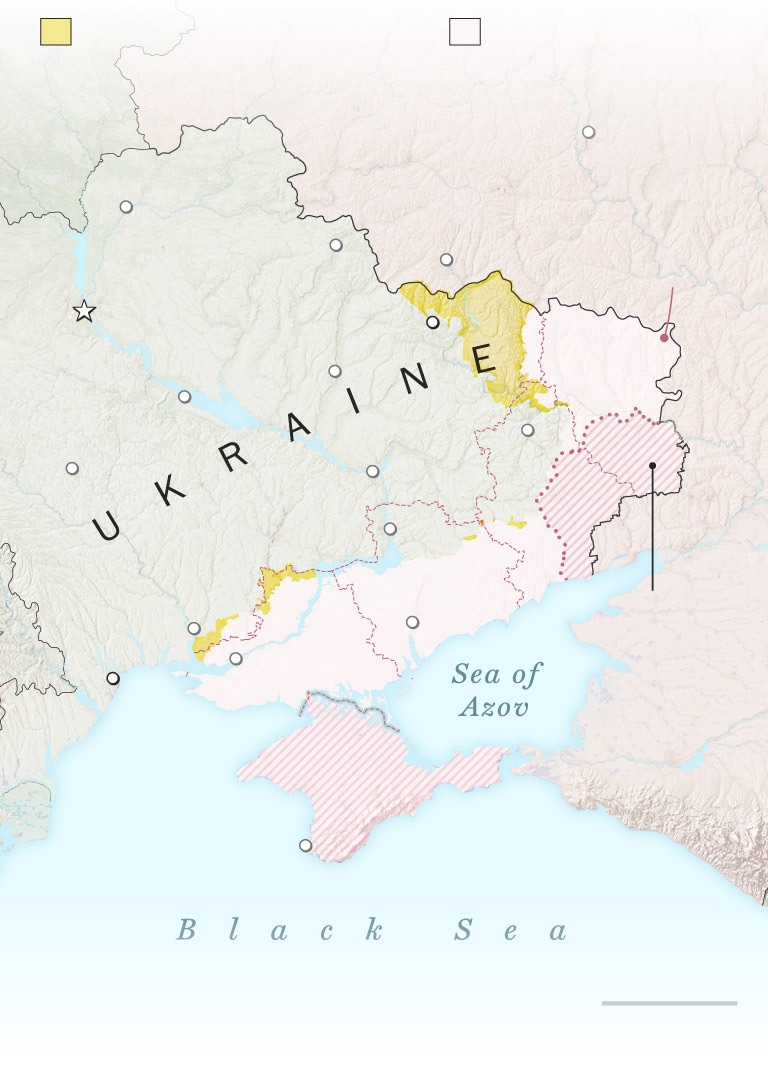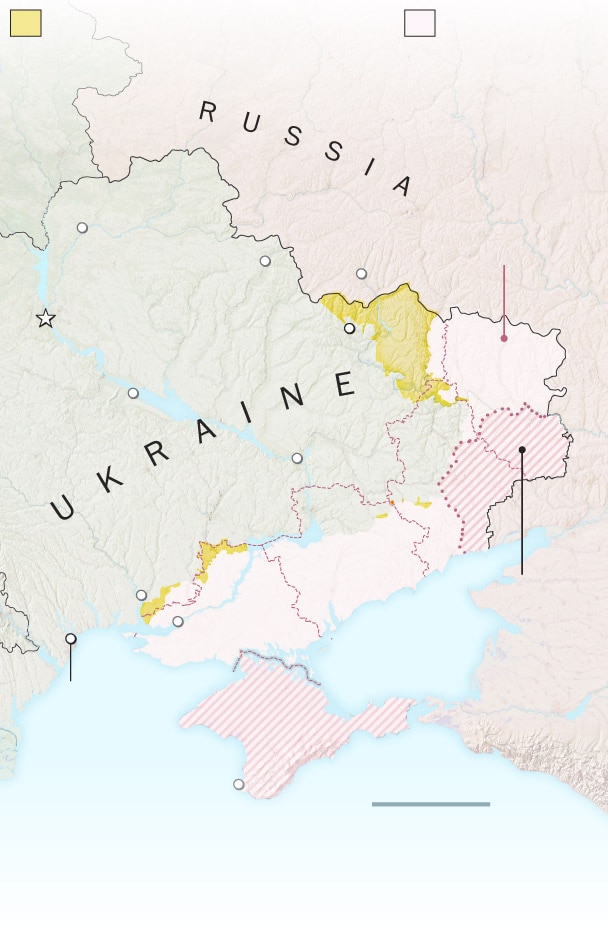Russian President Vladimir Putin signed decrees on Friday to annex four Ukrainian regions in a major escalation of his war in Ukraine. The move — and the staged referendums that preceded it — were widely condemned as illegal under international law.
What to know about Putin’s attempt to annex territory in Ukraine
The staged votes carried out ahead of Putin’s announcement were conducted at gunpoint or under other forms of duress, and Western officials panned them as a sham. Ukraine vowed to fight to reclaim all of its sovereign territory, as Western allies finalized plans to ramp up pressure on Moscow in response to the annexation.
The moves toward annexation came after Putin declared a partial military mobilization last week, sparking protests and prompting tens of thousands of Russian men to flee the country. The Kremlin’s announcements signaled a new willingness from Putin to escalate the seven-month war, after losing significant ground to Ukrainian counteroffensives in Ukraine’s northeast.
Analysts warn that annexing the territories could enable Moscow to label Ukrainian attacks on those regions as attacks on Russia itself, raising the threat of a retaliatory nuclear strike.
Here’s what we know about Russia’s annexation plans and their implications for Ukraine and its allies.
What do we know about Russia’s attempt to annex Ukrainian regions?
In near-synchronized announcements, Moscow-backed officials in four Ukrainian regions — Luhansk, Donetsk, Kherson and Zaporizhzhia — said last week that they would hold “referendums” from Sept. 23 to 27 on joining Russia. Putin quickly voiced his support.
Russia insisted the process and results were legitimate. But voting, which ended Tuesday, took place without credible international observers, and the entire process was under the control of the Russian government and occupying forces. Residents were visited in their homes and forced, sometimes at gunpoint, to check “yes” or “no” on joining Russia.
Russian state media claimed that 99 percent of voters in Donetsk favored accession, as did 98 percent in Luhansk, 93 percent in Zaporizhzhia and 87 percent in Kherson, according to Tass. Altogether, the Russia-occupied regions make up nearly 15 percent of Ukraine’s total territory, according to the Institute for the Study of War. But Russia’s hold on the region remains tenuous — about a quarter of Zaporizhzhia is still in Kyiv’s hands.
After the staged vote, the leaders of pro-Russian administrations in the occupied territories traveled to Moscow to formally ask Putin to absorb the regions into Russia.
“People have made their choice, an unambiguous choice,” Putin said in his speech Friday, calling on Kyiv to “immediately cease hostilities” and pledging Russia would “ensure security” and “never betray” residents of the Donetsk, Luhansk, Zaporizhzhia and Kherson regions. He then signed a series of accession treaties.
Parliamentary leaders in Russia said votes to absorb the four regions — mere formalities in the rubber-stamp legislature — are expected to take place early next week.

Four regions
where staged
referendums
on joining Russia
were held
Kirovohrad
Zaporizhzhia
ZAPORIZHZHIA
Area held
by Russia-
backed
separatists
since 2014
Annexed by Russia
in 2014
Novorossiysk
Sevastopol
Control areas as of Sept. 28
Sources: Institute for the Study of War, AEI’s Critical Threats Project

Ukrainian reclaimed territory
through counteroffensives
Russian-held
areas
Four regions
where staged
referendums on
joining Russia
were held
Kramatorsk
Zaporizhzhia
Area held by
Russia-backed
separatists
since 2014
Annexed by Russia
in 2014
Sevastopol
Control areas as of Sept. 28
Sources: Institute for the Study of War, AEI’s Critical Threats Project

Ukrainian reclaimed territory
through counteroffensives
Russian-held
areas
Four regions
where staged
referendums
were held on
joining Russia
Area held by
Russia-backed
separatists
since 2014
Annexed by Russia
in 2014
Sevastopol
Sources: Institute for the Study of War
Moscow recognized the separatist enclaves of Donetsk and Luhansk as independent before the invasion in February, and Russian-backed authorities had already taken administrative measures — including switching to the Russian ruble and distributing Russian passports — to bring residents of occupied Ukraine closer to Russia. Annexation formalizes Moscow’s control.
The United States warned in July that Russia was taking steps toward absorbing Ukrainian territoryand that Moscow’s plan would probably include calling “sham” votes.
“Russia is beginning to roll out a version of what you could call an annexation playbook,” White House spokesman John Kirby said at a news briefing.
That playbook was honed in Crimea, which Russia invaded and illegally annexed in 2014. The Black Sea peninsula had been part of independent Ukraine for more than two decades. The official result of the staged referendum held in Crimea in March 2014: 97 percent of voters allegedly backed joining Russia. Following the vote, Putin recognized Crimea as an independent state, and Crimea’s pro-Russian parliament formally applied to become part of Russia. Putin and Russia’s parliament then approved an accession treaty.
What is Moscow’s strategy?
The Kremlin’s speedy mobilization around annexation comes after Ukrainian counteroffensives reclaimed large swaths of territory in northeastern Ukraine that Russian forces had seized early in the war.
The staged referendums appeared to mark a “new phase of the war,” said Natalia Savelyeva, a fellow at the Center for European Policy Analysis. “They’re signs that the Russian regime doesn’t feel very comfortable.”
Hard-liners in Russia have demanded a tougher approach to the war, and they cheered calls this week for annexation.
Russia’s military control over the regions it has occupied is shaky, and the sham referendums have been seen as a political tool to accomplish the military aim of securing Moscow’s hold.
The idea was to create the pretext of popular support to justify further military action, Savelyeva said. For Putin and his backers, the appearance of having legal authority to make decisions remains important.
Britain’s Defense Ministry said Tuesday that Russia’s leaders “almost certainly hope” that an annexation announcement will fuel support for the “special military operation,” at a time when Moscow’s “partial mobilization” has increased Russian opposition to the war.
Tatiana Stanovaya, an analyst with R.Politik political consultancy, said in a Telegram post earlier this month that the staged votes constituted “preparation for a full-scale war,” and that annexation would be “an unequivocal ultimatum from Russia to Ukraine and the West: Either Ukraine retreats or nuclear war.”
Putin used the bulk of his speech Friday to rail against the West, making clear that he views the war in Ukraine as a broader conflict against the Western-backed international order.
In a not-so-veiled reference to Russia’s nuclear arsenal, Putin threatened Friday to defend annexed territories “with all available means.” Former president Dmitry Medvedev was more pointed: “Russia has the right to use nuclear weapons if necessary,” he wrote on his Telegram channel on Tuesday.
{Sigh} It’s here at last. As i wrote, referendums to annex Ukrainian territory into Russia. They’ve been laying this groundwork for months. Today, accompanied by harsher penalties for desertion and refusals. Here are considerations for what’s next (1/) https://t.co/zVNrNRnUqQ
— Dara Massicot (@MassDara) September 20, 2022
How have Ukraine and allies reacted?
Ukraine and Western countries have not recognized the annexation of Crimea, and they do not intend to recognize any absorption of other illegally annexed regions into Russia, either.
“Russia has been and remains an aggressor illegally occupying parts of Ukrainian land,” Ukrainian Foreign Minister Dmytro Kuleba tweeted. Ukrainian President Volodymyr Zelensky vowed to oust Russian forces and restore “normal life” to occupied regions. After Putin’s speech Friday, he announced Ukraine would apply for accelerated admission to NATO.
Ukraine’s NATO allies, meanwhile, blasted Russia’s apparent annexation and mobilization plans as escalatory. “Russia is violating international law, trampling on the United Nations Charter, and showing its contempt for peaceful nations everywhere,” President Biden said in a statement Friday.
Foreign ministers from the Group of Seven industrialized nations jointly said they would “never recognize” Russia’s “purported annexations nor the sham ‘referenda’ conducted at gunpoint.” The European Union unveiled a new round of sanctions against Russia on Wednesday in response to the referendums. The United States and Britain followed with their own additional sanctions on Friday.
Canada will also impose sanctions on individuals and entities “complicit” in annexation attempts, Prime Minister Justin Trudeau said this week.
Kyiv has requested tanks, longer-range missiles and other weaponry in response to Moscow’s threats of escalation. Zelensky accused Russia on Tuesday of carrying out “nuclear blackmail” and called for the West to take preventive action.
U.S. officials have indicated that the United States would continue to back the Ukrainian military if it tried to retake annexed land, and that an agreement that Ukraine would not strike Russian territory with U.S.-made weapons would not apply to illegally annexed areas. The Pentagon said Wednesday that it would more than double its commitment of long-range rocket artillery systems for Ukraine.
“There are powerful incentives for Ukraine to continue to attack this territory,” said Dara Massicot, senior policy researcher at the Rand Corp. “The Russian military is at its weakest point right now.”
Robyn Dixon in Riga, Latvia, Natalia Abbakumova, Karina Tsui, Paul Sonne, Yasmeen Abutaleb and Karoun Demirjian in Washington, Emily Rauhala and Beatriz Rios in Brussels, and Annabelle Timsit in London contributed to this report.






